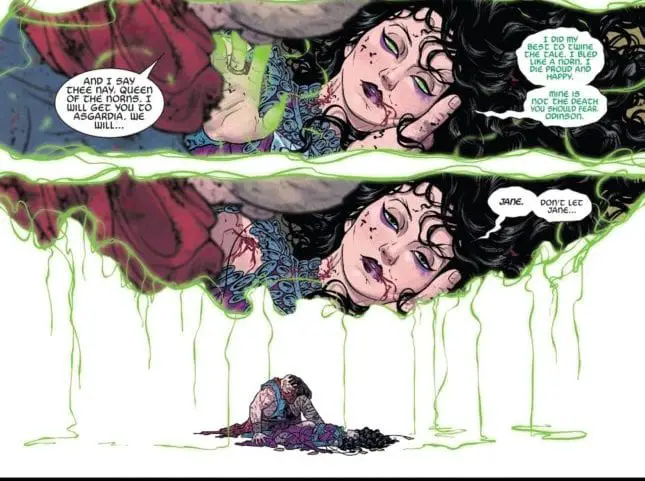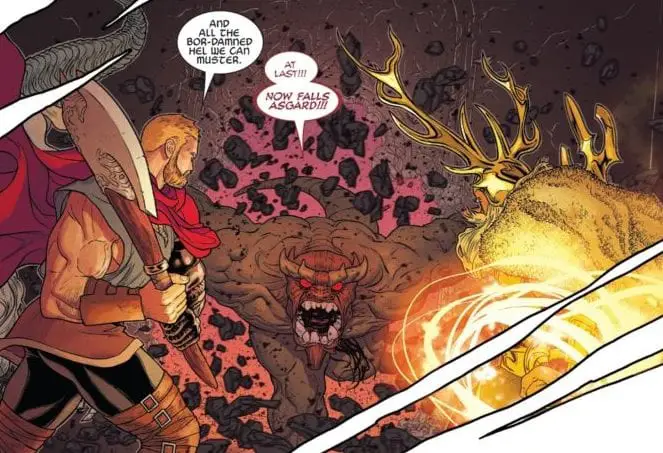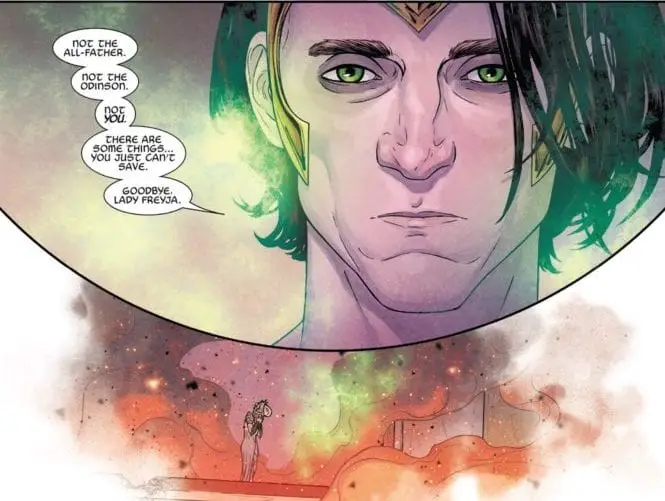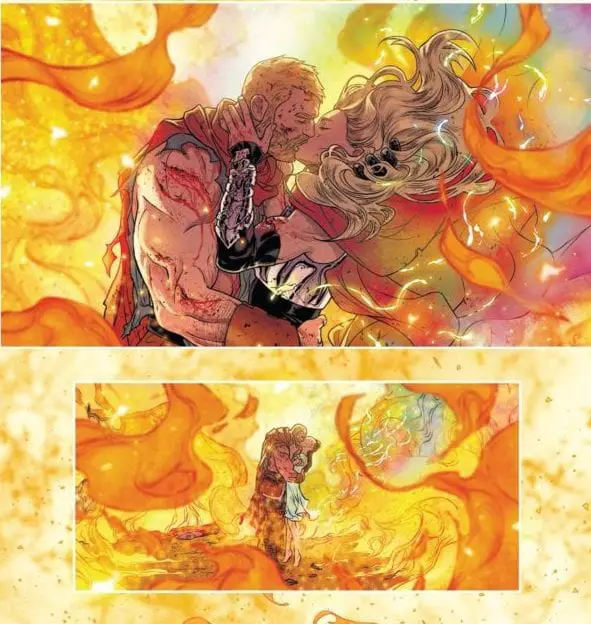This was it…the moment every fan of Jane Foster’s Thor either feared or dreaded. This eventuality has been nearly four years in the making since we first had the fortune of beginning a journey with one of the greatest Marvel heroes to ever grace the world of comics. Yet, fans knew that it would end, since the cancer ravaging Jane Foster’s human body would finally take its toll. For a while we could put this out of our minds, until early October 2017, when Jason Aaron began the final arc of this beloved comic: The Death of Mighty Thor. Interpretations be damned—this title told us all we needed to know. There was no play on words at work here and no misleading idea. It was time. Further cemented in our minds was the beautiful, yet horrifying cover for the 700th anniversary issue which launched the arc, featuring the same cover used to commemorate the death of Captain Mar-Vell.
After being a fan of this story for so long, among so many others, we expected this sensitive time to be handled with all the proper glory in terms of story telling that Jason had to offer, and I must say…he did not disappoint. What we’re given is one of the most harrowing tales to every come out of the painted pages of comic book history. An emotional saga in which my favorite rendition of the God or rather Goddess of Thunder meets her demise, but not before offering a tear jerking and awe-inspiring final stands. Mark this one down friends, because the penultimate issue may well shake you to your very core.
The War of the Realms is put in back seat…for now
This anniversary issue kicked off the beginning of the end for the series with a such finality that I couldn’t even allow denial to set in. The multi-layered oversize issue gave us some truly beautiful moments from the series as a whole, but also some of the most devastating. Straight to the point, the great villain of the coming pages was revealed towards the very end. If you’ll remember the previous story arc, the collective anger of a dead universe was entombed within the ultimate universe’s version of Mjolnir. Among the atrocities committed in Malekith’s war of the realms, a new and brutal Thor was born from anger of Volstagg. This fight left the war effort in such disarray that Odinson sought the counsel of the Norns.
Of course, no good came from this as the Nornkeep is attacked by a combined effort of allies among Malekith. With her dying breath, Karnilla gave us a terrible prophecy of the coming of the Mangog, a threat larger than the war.
Now one thing that I loved about this revelation is that it let us know that Aaron was putting the war of the realms in the back seat for this arc. A threat larger than the enslavement of an entire universe was coming and even the combined effort of Asgard would be able to stop its rampage. Clearly, this villain is stronger that the force of an entire intergalactic war, and Aaron uses this to set up at least some continuity when the series ends, for the war will continue to rage long after Jane leaves us. Karnilla says this as much before her demise and the great attack.

We are also given a show of strength just to instill the fear of how powerful this creature, the manifestation of a billion dead souls murdered by Odin. Since Volstagg nearly killed Jane, even as Thor, he was another threat that put the war of the realms in the back seat. Securing him from the hammer pulled some of the best warriors away form the fight and back to Asgard. Not long after does the call of the hammer call to him, giving him the power to seek it out again, sensing that a doom approaches. By the end of the issue, this begins with the start of a mighty battle between War Thor and the Mangog.
As I mentioned before, the war does take a back seat for most of this arc, but in the issue following the 700th, we get a combined story between the fight of Volstagg that shows just how sneaky and low Malekith can be. After Volstagg is found near dead, Malekith used the disorder to continue his conquest, nearly unopposed. Then the Asgardians did what they do best…fight among each other. If you remember, Loki stabbed Freyja with a poisoned blade that weakened her to a comatose state, causing a grieving Odin to give power to his brother, Cul. Yet when Jane, Odinson, and countless others urge him to act…the end comes.
This is about all we see for the war, but it sets up more conflict to come beyond the Mangog, especially considering Odinson will return as Thor after the ending of the series with Marvel‘s next reboot.
Asgard’s Final Defense
Now when I say the “final” defense, I say that in the most straightforward way possible. Not only was this arc the end of Jane, but in a twist of fate it would be end of Asgard as well. But more on that in a bit. During the argument between Cul and the rest of Asgard, both Odin and Freyja emerge from their absence to try and unite Asgard from a beast that would destroy them all. Before the fight actually begins, Jane ends up taking a turn for the worst and collapses. As Odinson returns her to Earth, Heimdall, and Cul begin their fight.

This is where the bulk of the action for this arc begins and strangely enough, Jane is not a part of it—not yet anyway. The stretched out fight is just as emotional as anything this comic has to offer. Odinson fighting side by side with his father once more is a spectacular sight as the two give it their all. Joining in this fight is also Freyja, who takes control of the Destroyer. Though she doesn’t last long, it serves to show just how desperate the fight when Asgard needs to employ every single defense it has; Frejya’s contribution is epic but ultimately futile.
It’s in this moment where we’re truly at a loss of hope thanks to the cowardice of Loki. He does reveal that he put her into a coma in order to keep Asgard out of the war of the realms without having to actually kill anyone. While the lie could be somewhat forgiven, his choice in the face of doom is not. He only appears to tell Freyja to accept his help in escaping, to save herself. However, she is a true Goddess of Asgard and chooses to die the badass she is rather than flee and live.

The Life and Death of Jane Foster
This was the most emotional I’ve been in a long time. While the fight was raging in Asgard, Jane was confined to her hospital bed. After her collapse before the fight, Doctor Strange was summoned to see just how bad her condition had become in the last few months. To put it simply, he tells her should she pick up the hammer one more time, Jane Foster will cease to exist. We can feel just how demoralizing this is to her. Not only does it make her feel powerless since she cannot fight to save a place very dear to her, but she is terrified of what is to come of the rest of her life.
The knife is only twisted further thanks to some well-placed flashbacks. In these, we see Jane confronted with her own mortality. The death of her mother, her diagnoses, her heart broken. All of these things shaped her into what she is today and the strength of her will. This is why she was worthy of the hammer in my opinion, and why in the end we all knew she was going to pick up that hammer for the last time. I can still feel the shiver up my spine and the tears in my eyes, even before her actual death, when she called for the hammer at the end of issue 705. The final act that set into motion the end.

The penultimate issue of the arc sees the final fight between Jane and the Mangog. We already know that once she drops the hammer, she will perish, which makes this final stand all the more significant. The fight is a little less then even-sided as the Mangog questions why she would die for these Gods who even she has hated at some point or the other.
In a desperate bid, Asgard is evacuated. Even Odin, who hates the new Thor agrees, his motives murky but true. The final act will be to steer Asgard along with the Mangog into the sun. While this nearly fails, the last move destroyed me. Jane wraps the Mangog in Mjolnir’s grip and sends it flying into the sun. The Mangog is destroyed, as is the hammer…and Jane.
While this isn’t the final issue in the series, the death of the mighty Thor still happened, and I’m left both broken and inspired by her sacrifice. She did not allow herself to die to kill the Mangog, but to give all the Gods and Goddesses the chance to become worthy again. In the end, her sacrifice was felt most keenly by Odinson, whose final goodbye is almost too painful to bear.
I hope all of you will join in the coming weeks to offer a proper final goodbye to Jane in the final issue of The Mighty Thor and a one shot commemorating Jane called The Gates of Valhalla. Until then, stay strong my friends and remember everything Jane Foster’s Thor has taught us.


